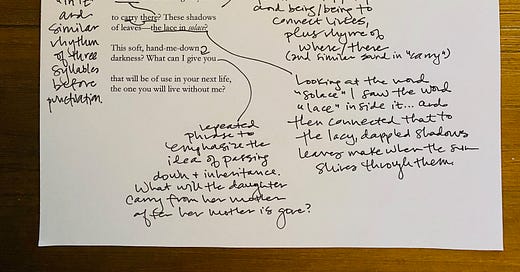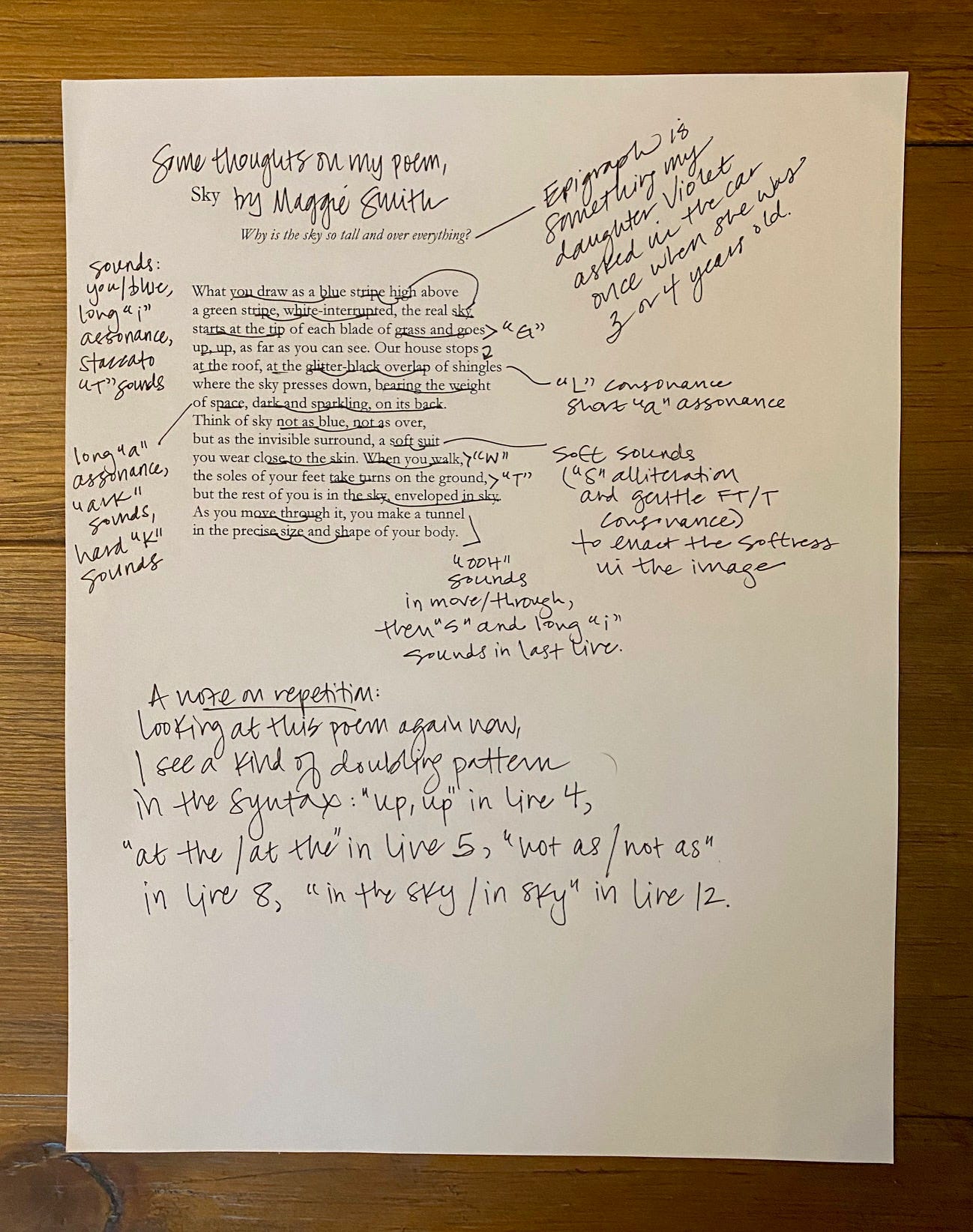Hi, Friend.
Today I’m sharing annotations of two poems from Good Bones: “Sky” and “At your age I wore a darkness.” I think of these two as sister poems in that book. Before “Sky” appeared in the book, it was first published in the August 2017 issue of Plume. “At your age I wore a darkness” was first published in the August 2016 issue of Nashville Review. (I didn’t realize until now that these poems were both published in August…and here we are again!)
“Sky” is from a series of poems in Good Bones that I call “nonnets,” as in not-quite-sonnets. They’re all fourteen lines long and, to my mind, have a turn in the last third of the poem, but they aren’t traditional sonnets. Each of these poems has as its epigraph a question my daughter asked me in the car when she was three or four years old: “What is the past?” “What is the future?” Or, in the case of this poem, “Why is the sky so tall and over everything?” (I have a theory that preschoolers hear the automatic car door locks click and know they have a captive audience. Time for existential questions on the way to CVS or the bank!)
“Sky” grapples with the question of where the sky begins and ends, and uses the classic childhood landscape drawing—blue at the top of the page for the sky, green at the bottom of the page for the ground, white in the center—as a jumping-off point. In the handwritten annotation below, I’ve noted some of the craft decisions I made related to syntax, repetition, sound, and line breaks.
“Sky” is one of my favorite poems to read aloud because of the dense patterning of assonance, consonance, and alliteration. Perhaps my favorite section—sonically—is this one:
Our house stops
at the roof, at the glitter-black overlap of shingles
where the sky presses down, bearing the weight
of space, dark and sparkling, on its back.
Reading these three and a half lines aloud, I hear how packed it is with music: short A assonance of black and overlap; the short I assonance of glitter and shingles; the staccato consonance (L, R, T) of the phrase “glitter-black overlap”; the long A of bearing, weight, and space; the AR sounds in dark and sparkling; the SP alliteration of space and sparkling; the hard K consonance in dark, sparkling, and back. I’ve marked other instances of sound play in the poem as well.
“At your age I wore a darkness” feels to me like a continuation of the conversation between parent and child in “Sky.” (“Once you asked, Does the sky stop?”)
Regarding line breaks, you’ll see that the phrase “What can I give you” is repeated three times in the poem, always at the end of the line and the end of the stanza, for emphasis. Other enjambments create some suspense, such as after the word field—the reader is likely imagining a meadow there before reading on and finishing the sentence. The end stops after the word stop in lines eight and fifteen, lines that mirror one another (“It doesn’t stop” and “We don’t stop”) create longer pauses, too—they enact (temporary) stops.
One of the things you can hear and also see in this annotation is the way repeated words and phrases are “stitched”—pardon the metaphor—from line to line. The repetition across lines in stanzas four and five (need/need, unravel/unraveling, stitch/restitch) is echoed later in stanzas eight and nine (stop/stop/stops, being/being).
I tend not to use a lot of alliteration, but there is a fair amount in this poem: holds hands/heads, fills/field, leaves/lace, down/darkness. Reading the poem aloud, I hear the rhyme (where/there, which also pulls in the long A and R in carry), the slant rhyme of vision and in it, the short O assonance in solace and soft, and the short U in hung and mother’s.
One of the most surprising moments in writing “At your age I wore a darkness” came when I considered the word solace and saw the word lace tucked inside it. I ended up tying that word-within-a-word to the image of sun coming through leaves, creating lacy shadows. Funny how you can’t hear the word lace inside the word solace, you can only see it.
Keep an eye out for a craft tip related to these sister poems—and, for paid subscribers, a writing prompt and a revision hack as well. Dear Lifers, thank you for supporting this newsletter, and through it, supporting my writing in general. I appreciate it.
Happy writing—
Maggie






Love this. So much inspiration, joy, and reflection the past few years has come from my daughter (now 6) making deep or off-the-wall comments and observations in random moments. (Why do you like to be alone? How do stars stay in the sky? Where do we go when we die? Does Bigfoot have big poops?)
I've never looked at revision/editing from the other side (finished) before and it is a smash idea. The usual critiquer says what's wrong but doesn't suggest any fix unless they rewrite your poem. These e-mails are wonderful and I look forward eagerly to each one.